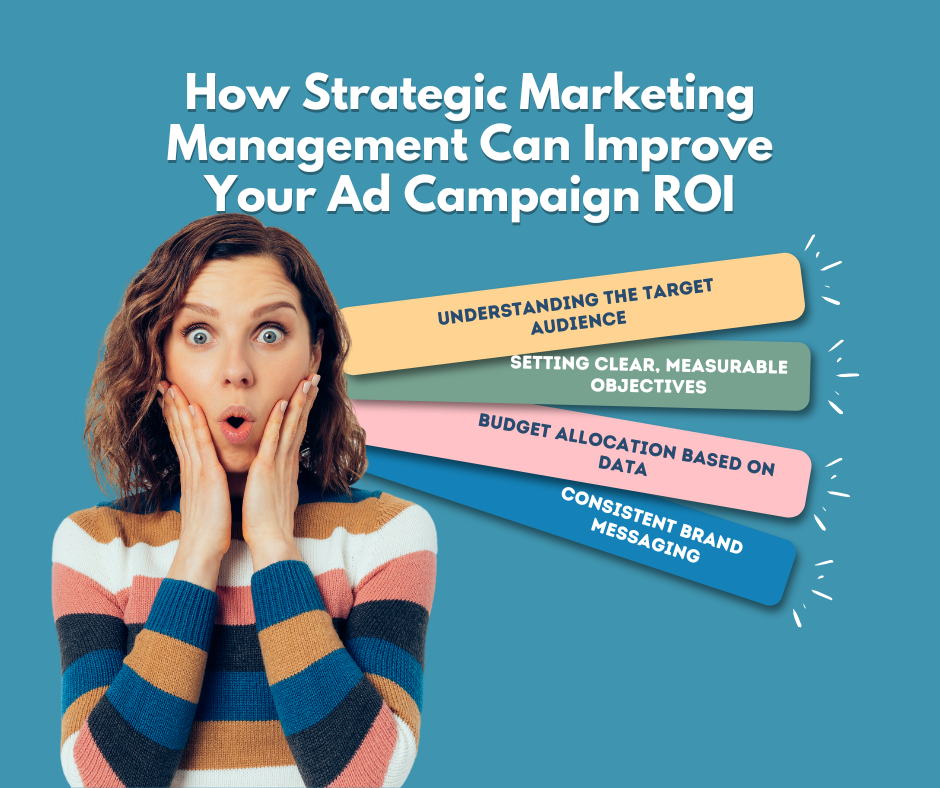In today’s highly competitive digital landscape, running ads without a clear strategy is like throwing darts in the dark—you might hit the target occasionally, but more often than not, you’ll waste valuable resources. This is where Strategic Marketing Management becomes essential. By applying a structured, data-driven approach to your advertising efforts, you can dramatically improve your Return on Investment (ROI) and achieve sustainable growth.
In this blog post, we’ll explore how Strategic Marketing Management principles can be applied to supercharge your ad campaigns and maximize ROI.
What Is Strategic Marketing Management?
Strategic Marketing Management involves the systematic planning, execution, and evaluation of marketing strategies to achieve long-term business objectives. Unlike tactical marketing, which focuses on immediate actions (such as creating ads or posting on social media), strategic marketing looks at the bigger picture—analyzing markets, setting clear objectives, aligning brand positioning, and continuously optimizing based on performance data.
At its core, Strategic Marketing Management ensures that every marketing action contributes to the company’s overarching goals while maximizing efficiency and minimizing waste.
Why ROI Matters in Advertising
Return on Investment (ROI) is one of the most important metrics in advertising. It tells you how much revenue you’ve earned compared to the money you’ve spent on your campaigns. A high ROI means you’re getting great value for your ad spend; a low ROI signals wasted budget and poor campaign performance.
By leveraging Strategic Marketing Management, you can implement systems and strategies that make every dollar of your ad budget work harder, delivering higher returns.
How Strategic Marketing Management Improves Ad Campaign ROI
1. Understanding the Target Audience
One of the foundational steps in strategic marketing is conducting deep market research and audience analysis. Without knowing who you’re targeting, it’s impossible to craft relevant messaging or choose the right channels.
How it boosts ROI:
- Audience Segmentation: By breaking your audience into specific segments based on demographics, behaviors, and preferences, you can tailor ads that resonate more strongly.
- Improved Targeting: Platforms like Facebook, Google, and LinkedIn offer advanced targeting options. Strategic marketing ensures you use these effectively, avoiding wasted impressions on uninterested users.
- Higher Conversion Rates: Relevant ads to the right audience naturally lead to better engagement and higher conversions.
2. Setting Clear, Measurable Objectives
A key aspect of Strategic Marketing Management is goal-setting using SMART objectives—Specific, Measurable, Achievable, Relevant, and Time-bound.
How it boosts ROI:
- Focus and Direction: Clear goals eliminate scattergun approaches. Whether your objective is lead generation, brand awareness, or eCommerce sales, your campaign can be optimized for that specific purpose.
- Performance Tracking: With measurable goals, you can track KPIs (Key Performance Indicators) like Cost Per Acquisition (CPA), Click-Through Rate (CTR), and Customer Lifetime Value (CLV), allowing better decision-making.
Example:
Instead of running a generic ad campaign, you might set a goal to “Increase website conversions by 25% over three months,” giving you a tangible benchmark to measure success.
3. Budget Allocation Based on Data
Strategic marketing is all about smart resource allocation. Instead of splitting your budget equally across platforms or guessing where to invest, decisions are based on past performance data and predictive analysis.
How it boosts ROI:
- Channel Prioritization: By identifying which channels deliver the highest ROI (e.g., Google Ads vs. Meta Ads), you can allocate more budget to what’s working.
- Avoiding Waste: Data-driven allocation minimizes spend on underperforming ads or irrelevant audiences.
- Scalability: Once you find winning campaigns, you can confidently scale them, knowing they’re backed by strategy and data.
4. Consistent Brand Messaging
A strong, consistent brand message builds trust, loyalty, and recognition. Strategic Marketing Management ensures that your messaging aligns with your brand’s values, tone, and customer expectations across all campaigns.
How it boosts ROI:
- Better Engagement: Consistency strengthens emotional connections with your audience, improving click-through and conversion rates.
- Reduced Confusion: Mixed or inconsistent messaging leads to brand confusion and missed opportunities.
- Long-term Value: Strong branding increases Customer Lifetime Value (CLV), meaning your ad spend pays off over a longer period.
Example:
Think of a luxury brand like Apple—their ads, whether on Instagram, YouTube, or TV, always carry a sleek, minimalist, innovative tone. Strategic consistency reinforces their premium positioning, driving high ROI.
5. Performance Measurement & Continuous Optimization
Strategic marketing doesn’t stop after launching a campaign—it involves constant monitoring, analysis, and iteration based on real-time performance data.
How it boosts ROI:
- A/B Testing: Strategic marketers systematically test variables like ad copy, visuals, and CTAs to find the highest-performing combinations.
- Data-Driven Adjustments: By reviewing KPIs regularly, you can quickly reallocate budget, pause underperforming ads, or tweak targeting settings.
- Learning Cycles: Each campaign generates valuable insights. Strategic management ensures that these learnings are documented and applied to future campaigns, continuously improving results.
Final Thoughts: Why You Should Incorporate Strategic Marketing
In the fast-paced world of digital advertising, every decision counts. Strategic Marketing Management brings clarity, control, and consistency to your campaigns, ensuring that each ad dollar contributes meaningfully to your business objectives.
By:
- Understanding your audience
- Setting clear objectives
- Allocating budget strategically
- Maintaining consistent brand messaging
- Continuously analyzing and optimizing
You’ll not only improve your ad campaign ROI but also create a sustainable, long-term growth strategy for your business.
Ready to get strategic? Start incorporating these principles into your ad campaigns today and watch your ROI climb!
